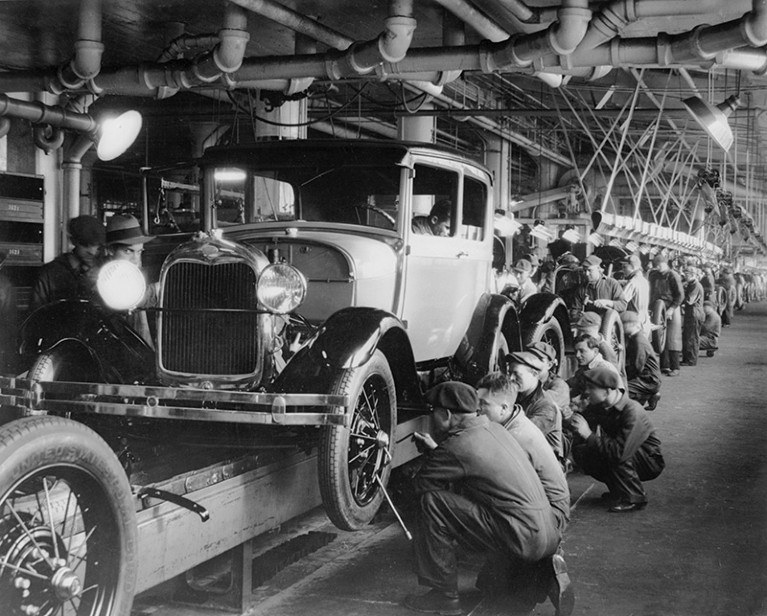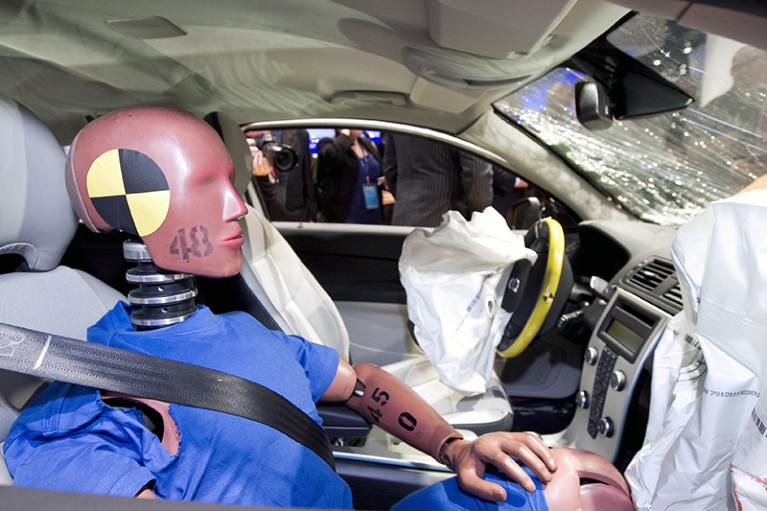
Ford cars under construction in Michigan in 1927.Credit: Hulton Archive/Getty
Moving Violations: Automobiles, Experts, and Regulations in the United States Lee Vinsel John Hopkins University Press (2019)
The story told by countless advertisements is that cars mean freedom — open roads, high speeds and boundless possibilities. The paradox is that, when we drive, we are perhaps more constrained than in any other area of everyday life. The German philosopher Max Horkheimer wrote in 1947, “It is as if the innumerable laws, regulations and directions with which we must comply were driving the car, not we.”
The shape of a car, the behaviour of a driver, the design of a traffic light and ultimately the configuration of a city are products not just of industrial ingenuity, but of an unfinished tussle between companies and regulators. Many of the rules and standards embodied in car design aim to keep us safe. Yet being in or around cars is among the most dangerous things we do. Some 1.35 million people die on the world’s roads every year. Developers of autonomous vehicles think this problem can be solved through artificial intelligence, but their technologies bring new safety concerns. Now, in Moving Violations, technology historian Lee Vinsel explains how the car became a fact of life in the United States, and how US regulators shaped this essential component of the American dream in an attempt to mitigate its extraordinary dangers.
Engineering: Broken bridges and highways from hell
In 1900, only 8,000 cars were registered in the United States. Handmade by businesses such as the Duryea Motor Wagon Company, these automobiles were playthings of the rich. And risk was part of the appeal. It quickly became clear that a privileged few were creating a public menace. A chaotic aftermarket of safety widgets offered drivers protection in what were then low-speed crashes; but more than 1,000 people were killed by motor vehicles in the United States in 1909. A year before that, the arrival of the Ford Model T made cars affordable for the middle classes, and by 1913 more than one million cars were registered. Safety became a major concern.
For Henry Ford’s mass production to work, it required standardization. Screws had to fit regardless of which factory they came from. And this was part of a bigger story — the standardization of streets, traffic signals, drivers and pedestrians. Road safety started to be acknowledged as a problem but, in their battle with government, carmakers found it easy to offload responsibility onto others. John O’Brien, the inspector in charge of traffic for the New York City Police Department in the 1920s, explained that the priority was to “educate the pedestrians”. However, through the concerted action of the insurance industry, regulators and researchers in organizations such as the Society of Automotive Engineers (founded in 1905), carmakers were persuaded that safer cars would be good for their bottom line. From the 1930s to the 1960s, the US road death toll climbed, but more slowly than the number of kilometres travelled. (It peaked at more than 50,000 deaths a year in the mid-1970s, then slowly declined.)
Research road map
As Vinsel shows, a history of science is woven through this regulatory tale. Researchers funded by public bodies such as what is now the US National Academies of Sciences, Engineering, and Medicine were confident that they could control risk through scientific knowledge. Psychologists at the National Research Council attempted to work out why some people were more “accident-prone” than others, and how driving tests and lessons could compensate for human failings. Some engineers — including former pilot Hugh DeHaven at Cornell University in Ithaca, New York — admitted that accidents were inevitable. They created the science of crashworthiness in the 1930s and 1940s. Here, the details become grisly. Experiments to work out how car design could protect human bodies began with dropping eggs from different heights and led to tests on live dogs and human cadavers (by the early 2000s, clad in “Smurf-blue leotards” to keep their extremities together after impact).

The science of ‘crashworthiness’ has been developing since the 1930s.Credit: Jeff Kowalsky/Bloomberg via Getty
In the mid-twentieth century, the debate about road safety became more technocratic and lost some of its passion. It was reawakened in the 1960s by campaigners such as consumer advocate Ralph Nader, whose reputation was enhanced by the industry’s attempts to discredit him. Nader blended scientific evidence with political nous to argue that carmakers’ disregard for safety was unjust as well as unwise. And under presidents Lyndon B. Johnson and Richard Nixon, the government began to assert itself on both car safety and environmental pollution. Manufacturers would no longer be able to add safety features just as a luxury. They were forced to develop technologies such as crumple zones to absorb impacts, and catalytic converters to meet tough laws imposed by the Environmental Protection Agency in the 1970s. Vinsel points out that the 2015 scandal in which Volkswagen admitted it had cheated on emissions tests has plenty of precedents from this period.
People must retain control of autonomous vehicles
Vinsel’s argument is that regulation involves the definition of problems. Scientific knowledge alone will not force action, and engineers need to be told what to focus on. In the history of car safety, problems have mostly been defined by carmakers, who have prioritized comfort over safety. Where they have focused on safety, the trade-offs have been problematic. The now-ubiquitous sports utility vehicle (SUV) — safer for drivers, but more likely to kill pedestrians — is a product of this view, and also a cautionary tale of unintended consequences. It was designed to be classed as a truck, and therefore exempt from emissions controls.
Vinsel wants to be optimistic. He sees his story as a case of government regulation steering technologies in a positive direction. His book, however, is entirely US-centric, even though the market for cars is global and technological standards have been exported and imported. His argument could have been more powerful with some international comparisons.
The US record on road safety remains woeful; the death rates per kilometre in Sweden and Britain are less than half those in the United States. Self-driving cars look like a poor technological fix for this problem. At a time when tech companies including Facebook, Uber and Google are given a free rein by US regulators and the specious promises of self-driving cars are used to justify further deregulation, a defence of government’s role in technological development is much needed.

 People must retain control of autonomous vehicles
People must retain control of autonomous vehicles
 Engineering: Broken bridges and highways from hell
Engineering: Broken bridges and highways from hell
 How the car became king
How the car became king





